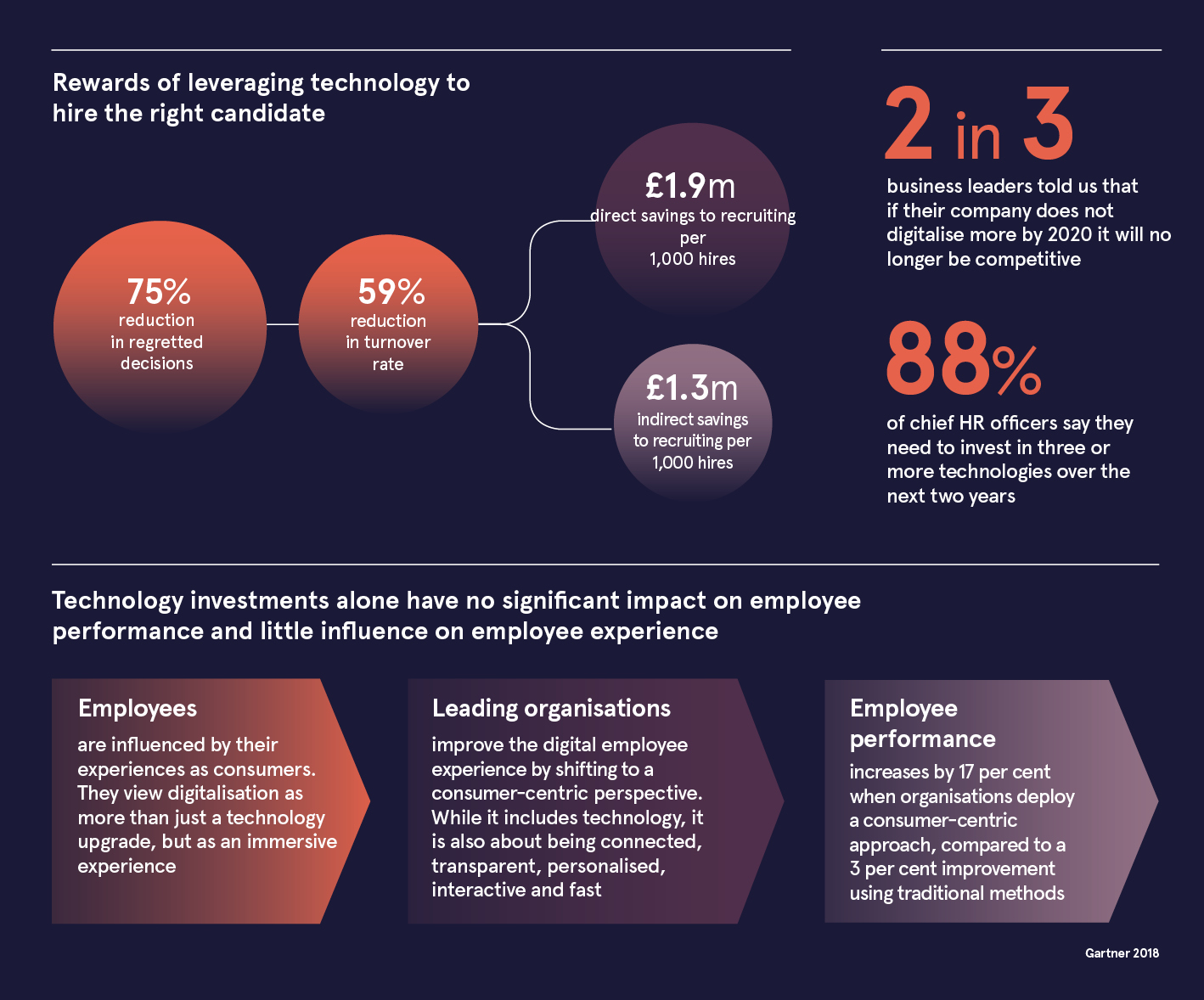
Dr Brian Kropp, group vice president of
Gartner Research & Advisory
Where do you see the biggest challenge for heads of HR?
The challenge is coming from digitalisation. That’s true for all roles in today’s organisation. In a recent survey, two thirds of business leaders told us that if their company does not digitalise more by 2020, it will no longer be competitive. But in HR, digitalisation is changing everything, from core functions like the way we hire and develop talent, to introducing new burdens such as raising performance. We found that 88 per cent of chief HR officers say they need to invest in three or more technologies over the next two years. It’s a huge undertaking and it’s no surprise many executives feel completely lost.
How is the way we hire changing and what is the cost of getting it wrong?
Let’s start with the applicants. In theory, this is a golden age for applicants. Unemployment is at a record low, around 4 per cent in the UK and United States, and candidates are overwhelmed with opportunities. But dig a little deeper and the picture is more complex. Candidates struggle to identify which jobs to apply for. They are overwhelmed with options. When they research positions online, they trawl through unfocused information. Digital forms make it easy for huge numbers to apply, so candidates wait longer to hear back from employers. The result is low engagement and regret on both sides. One third of new hires regret their decision, up by half in ten years. This is painful for HR departments as the cost of hiring is up 18 per cent in two years.
How can investing in technology improve hiring?
When you understand the causes of the problem, you can build targeted solutions. Since candidates are overwhelmed with information, some pertinent and some not, address this first. Offer clear information online about the role and the company, including the good, the bad and the ugly. That will filter out unsuitable and uncommitted candidates. Change your interview process to identify those most committed. Hotel chain Hilton automated its screening process to find passive signals of candidate interest. These are things the candidates are unaware of. At the heart of the process is an algorithm Hilton’s HR team built to identify top candidates, based on gathering data from high-performing employees. They can filter applicants at the front end and focus on the best ones. When you supply focused information, and intelligently guide candidates via digital techniques such as this, the number of regretted decisions decreases by 75 per cent. That’s a terrific improvement.
What impact can technology have on employee retention rates?
Technology can intervene to improve the way employees work. In fact, we know from earnings call transcripts that chief executives now expect HR to actively find ways of making employees happier. Currently only 29 per cent of employees believe HR helps them perform better. Clearly there’s a lot to do. Leading organisations are tackling this by using digital monitoring to identify how employees are feeling. Internal chat platforms such as Jabber, Yammer and Chatter are a goldmine. Scan these conversations to find out if IT is too slow to respond to queries or if there is frustration with a certain process. Then HR can fix it. So long as there is transparency over the policy, digital monitoring, or listening, is a great way to improve employee productivity and satisfaction, driving up retention.
Do some HR professionals feel digitalisation is outside their remit?
There is a reluctance to modernise. That’s natural as changing is hard, but there’s no alternative. Traditional HR methods are failing. Until recently, nine out of ten organisations used annual employee surveys to monitor opinions. These surveys are expensive and slow, and the information is often collected months after an issue was live. Why not experiment with cutting-edge solutions? Data-scraping can provide rich insights into employee behaviour. Employee location data can tell you where people are moving around the office and how office space can be optimised. Other more disruptive technologies such as the use of facial monitoring has potential; imagine a computer that tracks your emotions or a desk that understands your physiological markers and advises you to take a break when your temperature is rising. “Nudging” technologies like this can actually make us healthier. I’ve even seen two companies microchip employees.

Tell me about the role of line managers in the digital age.
Being a manager in today’s workforce is tough. Managers have too many employees to look after; the average number of direct reports has increased by 50 per cent in a decade. And managers have reduced visibility on how employees are spending their time as roles have changed too fast. Only 18 per cent of employees say their manager understands what their day-to-day work looks like. Our research has found that the best managers are those who can provide targeted feedback and coaching based on an employee’s needs, but also recognise when they need to connect employees to other individuals and opportunities for the right kinds of development. A “connector manager”, as we call it, actively connects employees to the right kind of coaching and development opportunities, instead of trying to do it all themselves. Ultimately, this management style has a greater impact on talent outcomes, increasing employee engagement by up to 40 per cent, their likelihood of staying with the organisation by up to 20 per cent and can even make employees more likely to go above and beyond at work.
How can HR connect investment in digitalisation with business outcomes?
The market for HR technology is lively, with thousands of vendors competing for attention, and it can be difficult to cut through the noise to identify what new HR technologies would be most beneficial. However, HR leaders play a critical role in ensuring that digitalisation is not only about technology. Technology is a key component, but investing in technology alone has no significant impact on employee performance or satisfaction. Leading companies are pursuing digitalisation as an experience for employees. While it includes technology, it is also about being connected, transparent, personalised, interactive and fast. All these components together create a consumer-centric, digitalised experience. Ultimately, digitalisation is a revolutionary force in HR. If you don’t adapt, you will find hiring costs soaring, retention falling and productivity flat-lining. But if you can identify the challenges and deploy digital solutions to each issue, the potential for improvement is sensational. It’s an incredible time to be in HR and I’m hugely optimistic about what can be achieved.
Leverage technology to improve employee performance at your organisation. Get on-demand access to exclusive content and discover
- Emerging HR technology trends and what to do about them
- How to build an effortless learning experience
- How to connect your technology investments with business outcomes
- How to identify which HR activities employees find valuable, as opposed to what HR thinks is valuable
Visit gartner.com/go/hr-digital or speak to a Gartner HR expert by emailing hrleaders@gartner.com
